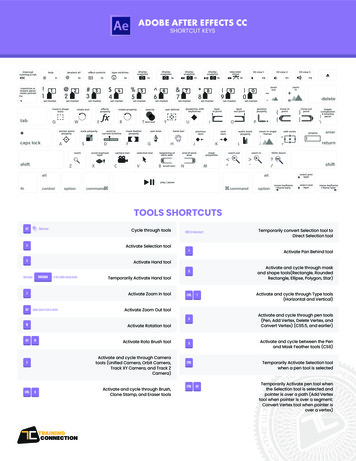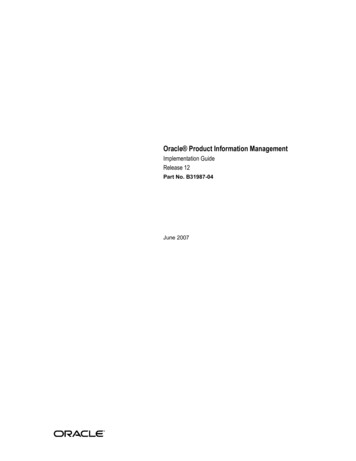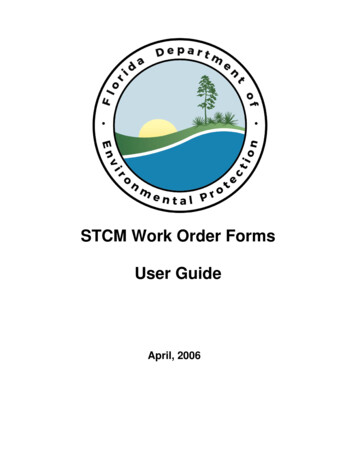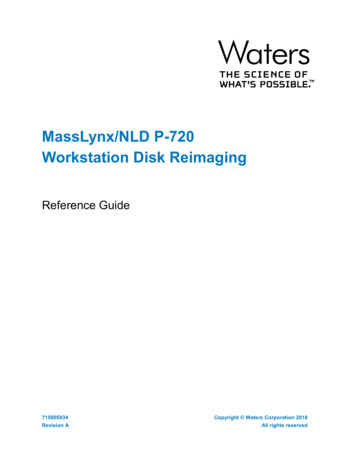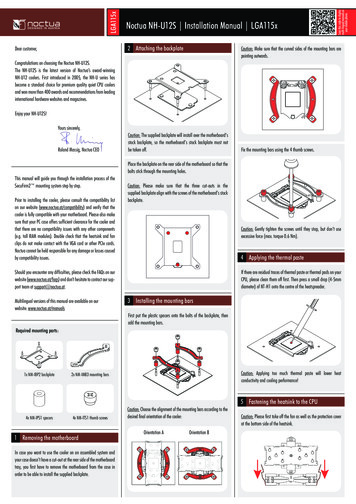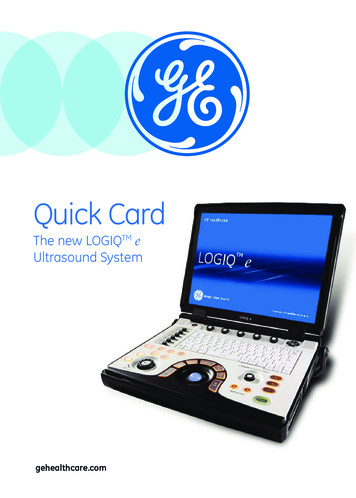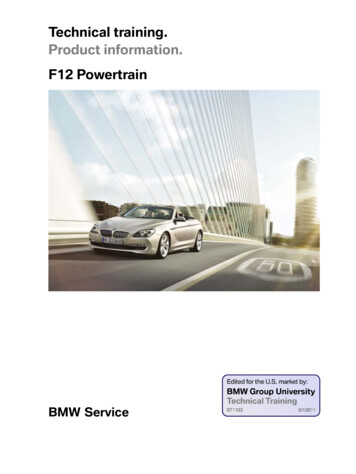
Transcription
Technical training.Product information.F12 PowertrainBMW Service
General informationSymbols usedThe following symbol is used in this document to facilitate better comprehension or to draw attentionto very important information:Contains important safety information and information that needs to be observed strictly in order toguarantee the smooth operation of the system.Information status and national-market versionsBMW Group vehicles meet the requirements of the highest safety and quality standards. Changes inrequirements for environmental protection, customer benefits and design render necessary continuous development of systems and components. Consequently, there may be discrepancies betweenthe contents of this document and the vehicles available in the training course.This document basically relates to the European version of left hand drive vehicles. Some operating elements or components are arranged differently in right-hand drive vehicles than shown in the graphicsin this document. Further differences may arise as the result of the equipment specification in specificmarkets or countries.Additional sources of informationFurther information on the individual topics can be found in the following: Owner's Handbook Integrated Service Technical Application.Contact: conceptinfo@bmw.de 2010 BMW AG, MunichReprints of this publication or its parts require the written approval of BMW AG, München.The information contained in this document forms an integral part of the technical training of the BMWGroup and is intended for the trainer and participants in the seminar. Refer to the latest relevant information systems of the BMW Group for any changes/additions to the technical data.Status of the information: November 2010VH-23/International Technical Training
F12 PowertrainContents1.Drivetrains. 11.1.Models. 11.1.1.Gasoline engines. 1Further information. 21.2.2.Engine. 32.1.N63 engine. 32.1.1.Technical data. 4Full load diagram. 52.1.2.Engine designation and engine identification. 62.2.2.2.1.Engine designation. 6Engine identification. 72.2.2.3.Automatic transmission. 8Designation. 83.1.3.2.Variants. 8GA8HP transmission. 83.3.3.3.1.Technical data.103.4.Transmission emergency release. 103.4.1.Mechanical transmission emergency release. 103.4.2.Electronic transmission emergency release. 123.5.Gear selector switch. 134.Manual transmission. 144.1.Designation. 14Variants.144.2.4.3.G manual transmission. 144.3.1.Technical data.154.4.Gearshift. 165.Rear axle final drive. 175.1.Designation. 175.2.Variants.175.3.Lightweight construction, rear axle final drive. 176.Driveshafts. 186.1.Driveshaft.186.1.1.Overview. 186.1.2.Crash function. 196.2.Output shafts. 196.2.1.Designation. 19
F12 PowertrainContents6.2.2.6.2.3.Variants. 19Overview. 19
F12 Powertrain1. DrivetrainsF12 Drive1.1. Models1.1.1. Gasoline engines640i (available 9/2011)650iN55B30M0N63B44O0Power KW/bhp235/315300/402Torque Nm/ ic transmissionGA8HP45ZGA8HP70ZRear axle final driveHAG 205ALHAG 225ALEngineExhaust emission standardsManual gearbox1
F12 Powertrain1. Drivetrains1.2. Further informationThe descriptions of the engines and the eight-speed automatic transmission can be found in the following technical training manuals:2 ST916 N55 engine ST610 covers the N63 engine ST914 F07 covers the GA8HP Automatic Transmission.
F12 Powertrain2. Engine2.1. N63 engineN63 engineFirst introduced with the X6, the N63 engine is the successor to the N62 engine. It is the first engineworldwide to feature an optimized package for integration of the turbochargers and main catalytic converters within the engine valley. The location of the turbochargers and catalytic converters (in the “v”space between the banks) means the locations of the intake and exhaust ports have been reversed. Inaddition, the resulting short pipe lengths and large cross-sections minimize the pressure losses on theintake and exhaust ports.Special features: Implementation in all model series (E71/E72, F01/F02, F04, F07/, F10) Twin exhaust turbochargers in the engine valley Catalytic converters are also mounted in the engine valley High Precision Direct fuel injection with piezoelectric injectors MSD85 engine control, liquid-cooled and FlexRay capable Indirect charge air cooling3
F12 Powertrain2. Engine2.1.1. Technical dataDesignValves per cylinderEngine controlN63B44O0F12, 650iV8V844ME9.2.3MSD85Displacement[cm ]47994395Stroke/bore[mm]88.3/93.088.3/89.0Power output at speedkW/bhp[rpm]270/3676300300/4005500 - 6400Torque at speedNm/ft-lbs[rpm]490/3613400600/4501750 – 4500Compression ratio[ε]10.5 : 110.0 : 1ROZ 91 – 98ROZ 91 – 98ULEV llULEV ll12.6/10.9-/10.75.5/5.65.03Fuel gradeExhaust emission standards4N62B48O1E64, 650iFuel consumption complying withEU combined(manual/automatic transmission)[l/100 km]Acceleration 0 – 100 km/h(manual/automatic transmission)[s]
F12 Powertrain2. Engine2.1.2. Full load diagramCompared to its predecessor the N62 engine, the N63 engine is characterized by a significantly higheroverall power output and boasts a linear torque curve.Full load diagram of E64 650i with N62B48O1 engine compared to F12 650i with N63B44O0 engine.5
F12 Powertrain2. Engine2.2. Engine designation and engine identification2.2.1. Engine designationIn the technical documentation, the engine designation is used to ensure unambiguous identificationof the engine. In frequent cases, however, only a short designation is used. This short form is used soan engine can be identified as belonging to a specific engine family.6ItemMeaningIndexExplanation1Engine developerM, NPSWBMW GroupBMW M SportBMW M GmbHBought-in engines2Engine type1456784-cylinder in-line engine (e.g. N12)4-cylinder in-line engine (e.g. N43)6-cylinder in-line engine (e.g. N55)V8 engine (e.g. N63)V12 engine (e.g. N74)V10 engine (e.g. S85)3Change to the basicengine concept01 – 9Basic engineChanges, e.g. combustion process4Working method orfuel type and possiblyinstallation positionBDHgasoline, longitudinally mountedDiesel, longitudinally mountedHydrogen5 6Displacement in 1/10liter303.0 liter7Performance classKUMOTSLowestLowerMiddleUpper (standard)TopSuper8Revision relevant toapproval01 – 9New developmentRedesign
F12 Powertrain2. Engine2.2.2. Engine identificationThe engines have an identification mark on the crankcase to ensure unambiguous identification andclassification.This engine identification is also necessary for approval by government authorities. With the N55 engine, this identification has been subject to a further development, with the previous eight positionsbeing reduced to seven. The engine number can be found on the engine below the engine identification. This consecutive number, in conjunction with the engine identification, permits unambiguousidentification of each individual engine.ItemMeaningIndexExplanation1Engine developerM, NPSWBMW GroupBMW M SportBMW M GmbHBought-in engines2Engine type1456784-cylinder in-line engine (e.g. N12)4-cylinder in-line engine (e.g. N43)6-cylinder in-line engine (e.g. N55)V8 engine (e.g. N63)V12 engine (e.g. N74)V10 engine (e.g. S85)3Change to the basicengine concept01 – 9Basic engineChanges, e.g. combustion process4Working method orfuel type and possiblyinstallation positionBDHgasoline, longitudinally mountedDiesel, longitudinally mountedHydrogen5 6Displacement in 1/10liter303.0 liter7Type approval matters(changes which require a new type approval)AB – ZStandardAs required, e.g. RON877
F12 Powertrain3. Automatic transmission3.1. DesignationA unique designation is used for the transmission in the technical documentation so it can be clearlyidentified. In frequent cases, however, only a short designation is used. This short form is used so thetransmission can be assigned to a transmission family. The GA8HP transmission family, consisting ofthe GA8HP45Z, GA8HP70Z and GA8HP90Z transmissions for example, is often Transmission2Type of transmissionAAutomatic transmission3Number of gears68Six forward gearsEight forward gears4Type of transmissionHPLRHydraulic planetary gear trainDesignation of General Motors PowertrainDesignation of General Motors Powertrain5 6Transferable torque19300 Nm gasoline engine26600 Nm gasoline engine32720 Nm gasoline engine45 (Zahn450 Nm gasoline engine, 500 Nm diesel enradfabrikgineFriedrichshafen)350 Nm gasoline engine45 (Gener700 Nm gasoline engine and diesel engineal Motors900 Nm gasoline enginePowertrain)390 Nm, 4th gear 410 Nm, gasoline engine70903907ManufacturerGJRZHGetragJatcoGeneral Motors PowertrainZahnradfabrik FriedrichshafenIn-house part3.2. VariantsModel650iEngineTransmissionTorque converterN63B44O0GA8HP70ZNW250H227TTD13.3. GA8HP transmissionThe new GA8HP45Z and GA8HP70Z automatic transmissions with eight forward gears and one reverse gear are used in the F12.8
F12 Powertrain3. Automatic transmissionSpecial features: Enhanced gearshift spontaneity Greater driving and shifting comfort as a result of a closer gear ratio Higher precision control of the converter lockup clutch at low engine loads High power transmission of the converter lockup clutch Reduced fuel consumption (-5% to -6%)The GA8HP45Z and GA8HP70Z are new developments and will gradually replace the established 6speed automatic transmissions GA6HP19Z TU and GA6HP26Z TU. The overall gear ratio has beenincreased from 6.04 to 7.07; the gear to gear ratios have are now closer, thus also reducing the differences in speed when shifting gear. The weight of the transmission has been reduced significantly using a plastic oil pan and other light weight components.The Electronic Transmission Control (EGS) control unit is integrated in the control unit framework ofthe electronic immobilizer EWS. This provides better protection against theft.It is operated via the gear selector switch or using the shift paddles (SA 2TB, automatic sports transmission, via the steering column switch cluster (SZL)).Mechanical torsional vibration dampers of the second generation are deployed in the torque converter: Turbine torsional vibration damper TTD Two-damper torque converter ZDW. (used on diesel applications of this transmission)9
F12 Powertrain3. Automatic transmissionThe function and structure of the torque converter are described in the “E70 Automatic transmission”training material available on TIS and ICP.The vibration isolation reduces the proportion of slip on the converter lockup clutch and enables alarger operating range with the converter lockup clutch closed. This reduces the fuel consumption by5% to 6% in the consumption cycle (KV01) compared to the TU 6-speed automatic transmission useduntil now.3.3.1. Technical dataGA8HP70ZMaximum powerkW/bhp380/509Maximum torqueNm/ftlbs700/516Maximum permissible engine speed, 1st - 7th gear[rpm]7200Maximum permissible engine speed, 8th gear[rpm]5700Maximum permissible engine speed, reverse gear[rpm]3500Ratio, 1st gear4.70Ratio, 2nd gear3.13Ratio, 3rd gear2.10Ratio, 4th gear1.67Ratio, 5th gear1.29Ratio, 6th gear1.00Ratio, 7th gear0.84Ratio, 8th gear0.67Ratio, reverse gear3.303.4. Transmission emergency releaseThe F12 features the new control concept for operation of the mechanical transmission emergency release. The transmission emergency release is no longer “mechanically” operated from the passengercompartment.3.4.1. Mechanical transmission emergency releaseThe mechanical transmission emergency release may only be operated by specially trained Servicepersonnel.10
F12 Powertrain3. Automatic transmissionTo actuate mechanical transmission emergency release, it is necessary to raise the vehicle and removethe underbody panelling.F12 Mechanical transmission emergency release GA8HPIndexExplanation1Adjusting screw2Parking lock leverATransmission parking lock engagedBTransmission parking lock releasedIn the event of a fault, the automatic transmission parking lock can be disabled via a mechanical emergency release function by turning an adjusting screw located directly on the transmission shift linkage.This mechanism is only accessible from underneath the vehicle and in some cases the belly pan mayhave to be removed.For detailed information on the mechanical transmission emergency release, refer to the corresponding repair instructions.11
F12 Powertrain3. Automatic transmission3.4.2. Electronic transmission emergency releaseOnly specially trained service technicians are permitted to actuate electronic transmission emergencyrelease.The vehicle must not be towed while electronic transmission emergency release is actuated; it mayonly be maneuvered. In case of misuse an entry is made in the fault memory.The electronic transmission emergency release can only be operated if the engine does not start butthe starter motor still turns.The electronic transmission emergency release function is active for fifteen minutes. This time is extended by a further 15 minutes as soon as a wheel speed signal is recorded. After this time period theparking lock is engaged without a Check Control message being displayed. The time specified is dependent on the battery capacity. Before operating the electronic transmission emergency release, secure the vehicle to preventit from rolling Depress and hold the brake pedal throughout the entire process Press the start/stop button-the starter motor will crank for a specific amount of timeElectronic emergency release for GA8HP transmission, using F25 as exampleIndexExplanation1Release button2Gear selector switch12
F12 Powertrain3. Automatic transmission Press the shifter release button (1) and hold it pressed Move gear selector switch (2) forwards one step (not all the way ) and hold it there for twoseconds (no more, no less) Release the gear selector switch (2) and move it forwards again briefly one step (not all theway )When the transmission position "N" is displayed in the instrument panel (KOMBI) - the transmission is unlocked electronicallyIf the start/stop button is pressed again, the parking lock is reactivated without a Check Control message being displayed.For detailed information on the electronic transmission emergency release, refer to the correspondingrepair instructions.3.5. Gear selector switchThe F12 features the gear selector switch already familiar from the F10.F12 Gear selector switch13
F12 Powertrain4. Manual transmission4.1. DesignationThe transmission designation in the technical documentation allows it to be uniquely identified. In frequent cases, however, only a short designation such as I, K, or G is used to identify the transmission.For the correct designation, refer to the following smission2Type of transmissionSManual gearbox3Number of gears1 – 9Number of forward gears4Type of transmissionXSWDYManual transmissionAll-wheel drive vehicle with manual transmissionSequential Manual Gearbox SMGAll-wheel drive vehicle with sequential manualtransmissionTwin-clutch gearboxAll-wheel drive vehicle with twin-clutch gearbox5 6Transmission type1726374553I transmissionD transmissionH transmissionK transmissionG transmission7Gear setBDSPGasoline engine ratioDiesel engine ratio (w)Sport ratiogasoline engine ratio, revised8ManufacturerGJRZHGetragJatcoGeneral Motors PowertrainZahnradfabrik FriedrichshafenIn-house part4.2. VariantsModel650iEngineN63B44O0Manual gearboxGGS6-53BZ4.3. G manual transmissionThe G manual transmission familiar from the E60 with N62 engine has been further developed for usedin the F12 650i with N63 engine. The maximum drive torque has been increased from 490 Nm to 600Nm.14
F12 Powertrain4. Manual transmissionThis means that an extremely high degree of precision, operational smoothness and top class shifting comfort are tangible to the customer. The total ratio spread of the transmission maximizes the utilization of engine performance. The shifting comfort is significantly higher, due in part to the short shifttravel distances of 55 mm.Special features: Slip suppression control system to prevent clutch slip Start-up engine speed limitation in order to minimize the work required to overcome friction ofthe clutch (in conjunction with the N63 engine) External transmission oil cooling (in conjunction with the N63 engine) Use of long term oil filling.A slip suppression control system is installed to prevent possible overloading of the clutch. This makesacceleration under full load conditions possible without the clutch slipping. The clutch slip is calculated via an engine speed pickup at the transmission countershaft and the engine torque is reduced asrequired.A start-up engine speed limitation system is used in conjunction with the N63 engine. This limits theengine speed to 3500 – 5500 rpm when the vehicle is at a standstill, depending on the mode of theDynamic Stability Control (DSC), which prevents thermal overloading of the drive plate during thestarting process.In conjunction with the N63 engine, the external transmission oil cooling system ensures that the vehicle operates reliably, even under extreme conditions. To achieve this, the transmission oil is pumpedthrough the transmission oil cooler by a transmission oil pump to cool it. The transmission has an integrated gearbox oil temperature sensor via which the transmission oil pump is switched on (transmission oil temperature 130 C) or off (transmission oil temperature 110 C).4.3.1. Technical dataG transmissionGS6-53BZEngine applications in F12N63B44O0Maximum drive torqueNm/ft-lbs600/450Wheelbase[mm]94.96Weight with oilkg/lbs57.6/126.7Oil quantity[l]2.2Transmission length[mm]669Ratio, 1st gear4.055Ratio, 2nd gear2.396Ratio, 3rd gear1.582Ratio, 4th gear1.192Ratio, 5th gear1.00015
F12 Powertrain4. Manual transmissionG transmissionGS6-53BZRatio, 6th gear0.872Ratio, reverse gear3.677Axle ratio3.084.4. GearshiftSpecial features: Further development of typical BMW gearshift Improved shifting force characteristics and shifting precision New gearshift arm concept, harmonized with innovative center console design New sporty design of single-piece gearshift lever knob with leather cover New "Dakota" leather material (improved longevity and optics) Ergonomically-optimized harmonization of center console and gearshift knob position Optimum ergonomics with different versions for left and right-hand drive vehiclesThe rod gearshift system and tried-and-tested concept of direct connection to the transmission havebeen retained.16
F12 Powertrain5. Rear axle final drive5.1. DesignationItemMeaningIndexExplanation1 – 3Type of transmissionHAGRear axle final drive4 – 6Overall size205225Diameter of crown wheel pitch circle in mm7Housing typeAAluminium8Type of transmissionLSmooth running5.2. VariantsModelTransmissionRear axle final driveGear ratio i650iGS6-53BZHAG 225AL3.08650iGA8HP70ZHAG 225AL3.085.3. Lightweight construction, rear axle final driveAs is the case in the F01, F07 and F10, the new rear axle final drive HAG 225AL with aluminium housing is installed.F12 Lightweight construction, rear axle final driveSpecial features: Lower weightHAG 225AL: 29.7 kg (incl. oil) Greater power transmission Better efficiency.17
F12 Powertrain6. Driveshafts6.1. Driveshaft6.1.1. OverviewTwo variants of the steel driveshaft are used depending engine-transmission configuration.Special focal points of the F12 driveshaft design were the torque transfer and comfort requirements inrelation to acoustics and vibrations.The joints, shaft divisions and shaft diameters have been designed to prevent disruptive noises or vibrations being passed on through the connection points to the body.The F12 driveshafts are connected to the manual or automatic transmission and to the rear axle finaldrive exclusively using flexible discs. This minimizes the high-frequency gear meshing noises on therear axle final drive.F12 Propeller shaft18
F12 Powertrain6. DriveshaftsIndexExplanation1Flexible disc (at automatic or manual transmission)2Center mount3Flexible disc (on rear axle final drive)4Plug connection5Universal joint6Collapsing element connection7Crash function6.1.2. Crash functionIn the event of a head-on collision, the driveshaft absorbs a portion of the crash energy. The propertiesof the so-called crash function, which is integrated in the front driveshaft tube, have been optimized.The force at which the front driveshaft tube selectively deforms has been reduced once again compared to the E63. The torque transfer capability has remained unchanged.6.2. Output shafts6.2.1. DesignationItemMeaningIndexExplanation1 2Joint typeVLLöbro sliding joint3 – 7Designation3300i4100iIdentification, construction size/transfer capability6.2.2. VariantsModelTransmissionRear axle final driveOutput shaft650iGS6-53BZHAG 225ALVL-4100i650iGA8HP70ZHAG 225ALVL-3300i6.2.3. OverviewF12 Output shaft19
F12 Powertrain6. DriveshaftsThe F12 features output shafts that are inserted onto the gear and differential side.The journal version towards the rear axle final drive depends on the size of the rear axle final drive. Thejournal to the wheel hub is designed in only one size.The positioning of the rear axle final drive means the left and right output shafts have different overalllengths.The splined shaft between the two joints is designed as a torsionally-rigid hollow shaft.20
Bayerische Motorenwerke AktiengesellschaftHändlerqualifizierung und TrainingRöntgenstraße 785716 Unterschleißheim, Germany
transmission can be assigned to a transmission family. The GA8HP transmission family, consisting of the GA8HP45Z, GA8HP70Z and GA8HP90Z transmissions for example, is often mentioned. Item Meaning Index Explanation 1 Designation G Transmission 2 Type of transmission A Automatic transmission

